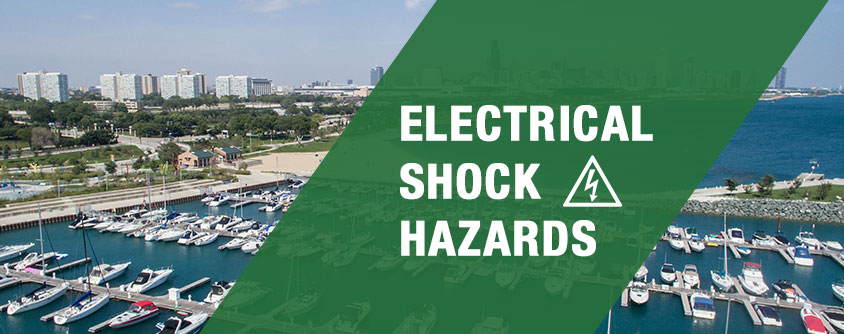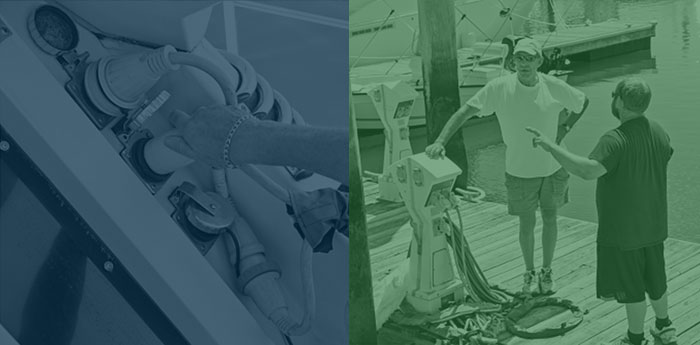
Understanding the Risks of Water & Electricity
Boating Safety Awareness Series—A Public Service of the National Marine Manufacturers Association
FACT SHEET
Electricity kills swimmers, boaters and people in marinas every year.
These deaths occur because of boat and marina wiring problems, component failures or the use of improperly wired household appliances run by AC shore power. Virtually all of these accidents are avoidable.
While AC electrical power is potentially deadly in any location, it is especially dangerous in and around the water.
An electric shock can come from faulty boat or marina wiring in contact with water, concrete or metal docks. Electricity may be present on metallic objects such as marina electrical equipment and shore power connectors or even in the water. Contact with electrically energized equipment may result in painful shock, burns, muscle contraction or paralysis, loss of breathing and even stopping of the heart.
Electricity may be present in the water in places where boats are connected to shore power or where marina wiring is defective.
Electricity in the water at low levels will paralyze swimmers to the point they lose muscle control, cannot swim, and instantly drown. This is commonly known as electric shock drowning. At higher levels the electrical “field” can be strong enough to cause electrocution by cardiac arrest.
The risk of electric shock drowning or in-water electrocution is greater in fresh water.
Electricity cannot be detected without the use of specialized test equipment.
Proper training, techniques and specialized test equipment are required to detect electricity in water.

CHECKLIST
When connecting to shore power:
- Dock only at a reputable marina. Get permission from the marina before connecting to a dock receptacle. Ask if the “polarity” and ground are correct and when they were last checked. If you have any questions or concerns, do not use the shore power at that facility.
- Shore power cords and adapters must be clean and dry before use. If they are dropped overboard, do not use until allowed to dry. Keep shore power inlet covers tightly closed when not in use.
- Handling shore power cords when you are barefoot increases your chance of being electrocuted.
- Make certain there are no swimmers in the water around your slip.
- Shut off both the boat’s main AC circuit breaker and the dock breaker.
- Connect the shore power cord at the boat first, then connect the cord to the dock receptacle.
- Turn on the dock breaker.
- Check the boat’s “polarity” alarm or light (if it has one) on the AC panel as soon as the dock breaker is turned on. If the polarity is incorrect, shut the dock breaker off and disconnect the dock end of the shore power cord immediately. Report the problem to the marina. The marina should contact a qualified electrician to make corrections.
- Turn on the boat’s main AC breaker only if the “polarity” alarm is not lit up (if it has one).
When disconnecting from shore power:
- Shut off the boat’s main AC circuit breaker.
- Turn off the dock breaker.
- Disconnect the dock end of the shore power cord. This should always be done first.
- Disconnect the shore power cord at the boat receptacle.
- Clean and dry the shore power cord
Once a year, have a qualified marine electrician perform at least the following:
- Verify the integrity of the boat’s entire AC shore power grounding system, including the connection to the DC system negative.
- Verify that any galvanic isolators (if installed in your boat) meet current American Boat & Yacht Council (ABYC) standards and are fully functional.
- Inspect shore power cords, adapters and boat receptacles for any signs of deterioration, including cord wear, loose connections, signs of sparking or overheating and bent or pitted blades. If there are any such signs, correct and test the equipment or replace it.
- Operate the boat’s electrical system at full load (everything on) and check for AC system leakage or voltage between the boat’s underwater fittings (bonding system, if equipped) and the shoreside AC system ground.
WARNING
WATER AND ELECTRICITY DO NOT MIX!
To avoid electrical shock injuries and death DO NOT:
To avoid electrical shock injuries and death DO NOT:
- Swim in marinas
- Handle shore power cables without footwear
- Alter shore power connectors or cables
- Use “homemade” adapters or cordsets without the UL mark
- Connect to a receptacle with a different configuration than the plug
- Connect portable tools, portable battery chargers or extension cords to outlets or adapters intended only for supplying power to boats
In the event of an in-water (or onboard) electrical accident:
- Turn off and unplug the power to all boats in the area before attempting rescue
- Remove the victim from the water while trying to avoid getting into the water yourself. Don’t become a victim yourself!
- Summon help
- If needed, begin rescue breathing or CPR (as appropriate)
WHAT TO DO
- NEVER swim in a marina or in other areas where boats are connected to shore power.
- Use only shore power cords and adapters that are in good condition. When in doubt, replace them or have them repaired by a qualified marine electrician.
- Purchase and use only products that are “factory” assembled by a recognized manufacturer and have the UL listing mark. Read and follow the manufacturer’s instructions and warnings. Do not use “homemade” adapters or shore power cords.
- Always wear “rubber” soled shoes (such as deck shoes or gym shoes) when handling electrical equipment. Try to avoid touching other metallic objects when working with shore power cords.
- When using “straight blade” portable tools, portable battery chargers or extension cords, always ensure these tools are connected to a ground fault circuit interrupter (GFCI) protected receptacle.
- If a boat inspection or repair requires a person to be in the water, disconnect the boat and all nearby boats from shore power (with the boat owner’s and marina’s permission). Before entering the water, check the water for the presence of electricity with a voltmeter or other test equipment.
To find out more information about how to avoid electrical shock hazards on recreational boats and how to make boating safer, contact:
National Marine Manufacturers Association
231 S. LaSalle Street, Suite 2050
Chicago, IL 60604
nmma.org
312.946.6200
231 S. LaSalle Street, Suite 2050
Chicago, IL 60604
nmma.org
312.946.6200
United States Coast Guard
Office of Auxiliary and Boating Safety
Commandant (CG-BSX-2) Stop – 7501
2703 Martin Luther King Jr. Ave., S.E.
Washington, DC 20593-7501
uscgboating.org
202.372.1062
Office of Auxiliary and Boating Safety
Commandant (CG-BSX-2) Stop – 7501
2703 Martin Luther King Jr. Ave., S.E.
Washington, DC 20593-7501
uscgboating.org
202.372.1062
American Boat & Yacht Council, Inc.
613 Third Street, Suite 10
Annapolis, MD 21403
abycinc.org
410.990.4460
613 Third Street, Suite 10
Annapolis, MD 21403
abycinc.org
410.990.4460
National Fire Protection Association
One Batterymarch Park
Quincy, MA 02169-9101
nfpa.orgv 617.770.3000
NFPA 70 (National Electrical Code)
Article 555 (Marinas and Boatyards)
NFPA 302 (Motorcraft)
NFPA 303 (Marinas and Boatyards)
One Batterymarch Park
Quincy, MA 02169-9101
nfpa.orgv 617.770.3000
NFPA 70 (National Electrical Code)
Article 555 (Marinas and Boatyards)
NFPA 302 (Motorcraft)
NFPA 303 (Marinas and Boatyards)
This brochure is published by NMMA for educational purposes only and it should not be assumed that all relevant safety information is included herein. NMMA makes no guarantee, representation or warranty, express or implied, at law or in equity, as to the validity, accuracy or sufficiency of the information included in this brochure. NMMA assumes no responsibility or liability for any injuries, claims, losses or damages arising in connection with the use of or reliance on the information included in this brochure.
POWERED BY 
